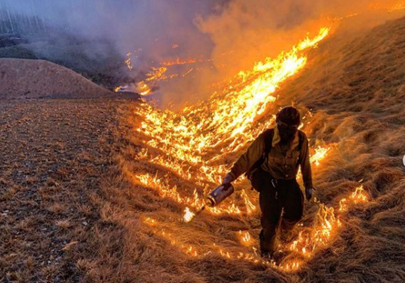The State of Alaska Division of Forestry and Fire Protection manages an active hazard fuel mitigation program. The objective is straight forward; remove enough vegetation (fuel) so that when a wildfire burns, it is less severe and can be more easily managed. DOF’s protection responsibilities are geographically split into six sperate areas. Each area plans and implements fuel reduction projects strategically identified through land managers, fire management, cooperative agencies, and wildfire protection plans.
To augment area level capacity, and to provide coordination and standardization DOF employs State and Regional positions:
Statewide Fuels Coordinator - Darren Finley (darren.finley@alaska.gov)
Coastal Region Fuels Specialist - Ethan DeBauche (ethan.debauche@alaska.gov)
Northern Region Fuels Specialist - Josh Turnbow (josh.turnbow@alaska.gov)

Fuel Mitigation
Fuel Disposal
DOF partners with local governments throughout Alaska to provide funding specifically for fuel disposal. Offering the public a location to safely dispose of woody debris taken around residential property reduces risk of an escaped debris burn, assists with mitigation of invasive species (Spruce Beetle), and reduces the fuel load of the property. Ultimately reducing risk from wildfire.

Prescribed Fire
DOF recognizes prescribed fire on the landscape as an option for proactive Fire Management and hazardous fuel reduction. Alaska faces a real challenge when proposing prescribed fire as our ideal burning window historically falls within in our most active fire burning period. DOF continues to invest in prescribed fire training opportunities for our staff that prepares firefighters and managers to plan and execute prescribed fires safely and effectively.

Community Wildfire Protection Plans (CWPP)
A Community Wildfire Protection Plan (CWPP) identifies and prioritizes areas for hazardous fuel reduction treatments and recommends the types and methods of treatment on Federal and non-Federal land that will protect one or more at-risk communities and essential infrastructure and recommends measures to reduce structural ignitability throughout the at-risk community. A CWPP may address issues such as wildfire response, hazard mitigation, community preparedness, or structure protection.
Funding Streams
- Western States Fire Managers Wildland Urban Interface (WUI) Grant
- Non-Federal Hazardous Fuels - This funding source is granted through the United States Forest Service (USFS) and has been utilized primarily for assistance with hazard fuel disposal sites across Alaska.
- State of Alaska Fuel Breaks CIP - The State of Alaska Legislators have appropriated funding in the form of a Capital Improvement Project with intent to provide fuel breaks from wildfire across the landscape of Alaska.
- Community Wildfire Defense Grants (CWDG) - upcoming Fall of 2022. Federal bipartisan infrastructure bill aimed at proactive fire management nationwide. DOF will administer this funding source for eligible stakeholders.
Contracting Opportunities
All invitations to bid will be advertised through the State of Alaska Online Public Notices website. All Requests for Information will be advertised through the same system.
- State of Alaska Online Public Notices (https://aws.state.ak.us/OnlinePublicNotices/)
